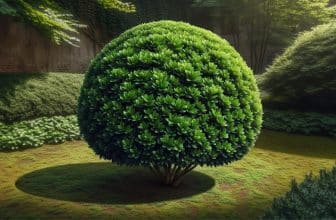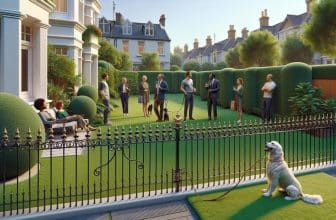Designing Your Backyard Garden: Tips and Tricks

Creating an outdoor garden can be an exhilarating and challenging endeavour. Assembling a plan, determining the appropriate plants to include, and designing a beautiful and functional space can be overwhelming. However, it is possible to transform any backyard into a marvellous garden paradise with some preparation and imagination.
It’s essential to consider the size of the space and select the right plants, as well as to incorporate hardscaping elements and a garden color scheme that complements the area. This guide will provide all the necessary tips and tricks to create an inviting and beautiful garden in which you will enjoy spending time.
Climate Considerations
Western Provinces
Central & Prairie Provinces
Eastern Provinces
Regardless of the region, Canadians need to consider the average temperature, amount of rainfall, and the length of the growing season when selecting plants for their backyard. Choosing plants well-suited to the local climate is important to ensure they thrive and produce a bountiful harvest.
Backyard Garden Design Ideas
For Canadians, planning and designing their backyard garden is of great importance because it not only enhances the beauty of their property but also provides them with fresh produce and a space to relax and enjoy the outdoors.
Proper planning and design also ensure efficient use of outdoor living space, allowing for the growth of various plants and vegetables. In addition, incorporating native plants can attract local wildlife and contribute to the preservation of the environment.
Here are some tips to help you plan and design your backyard garden in Canada.

Garden Layouts
When it comes to landscaping, homeowners have a wide range of design possibilities, similar to the variety of home decor styles available.
A Backyard can be a tranquil haven for relaxation, a playground for kids and/or pets, and a fruitful area for gardening. Homeowners can choose from traditional in-ground rows, raised garden beds, or a combination of both to cultivate their lush oasis.
Garden Beds Layout
Constructed with wood, bricks, or other materials, raised beds are filled with high-quality potting soil, compost, and/or leaf mould to provide maximum drainage. Raised beds are ideal for areas with stony, compacted, contaminated, very wet, or nutrient-poor soils, making them a great choice for the avid gardener.
Kitchen Garden Layout
Flower Garden
Water Features

Fountain
A fountain can bring a timeless aesthetic to your garden while providing a soothing soundscape. Whether you prefer a traditional tiered design, a modern abstract piece, or a wall-mounted fountain, you can find one that complements your garden. Fountains create a captivating display of sight and sound, making them the perfect addition to any garden.
Stream
Waterfall
Pool
Bird Bath
Water Bowls & Ponds
Well
Lighting

It is essential to have the right type of landscape lighting for any outdoor setting. Creative lighting designs can quickly transform your premises into a functional and beautiful space to enjoy in the evening. These lights can highlight focal points, such as trees and plants, and create different areas for entertaining, dining, or socializing.
When creating your lighting plan, it may be beneficial to sketch out your yard to help you visualize where to place lighting to meet specific needs.
Light Posts
Landscape post lights and bollard lights can add a subtle touch of ambiance to any outdoor area. These lighting fixtures can stand alone or be mounted in areas such as around the patio, a garden pathway, a driveway, a deck, or a fountain. They are often used to highlight a garden feature, delineate a walkway, or illuminate a pond or feature plant. Light from these fixtures can be distributed evenly to create an all-encompassing glow or focused down onto the ground for more specific lighting needs.
String Lights
Spotlights/Floodlights
Hardscape Lights
Inground Light
Lanterns
Fire Pit
Furniture & Garden Structure

Modern gardens are becoming increasingly like living rooms, with outdoor sofas, coffee tables and rugs overtaking the traditional six-seater dining tables and bistro sets. When choosing furniture for your garden, there are a few key things to consider.
First and foremost, you’ll want to think about the style and aesthetic you’re going for. Do you want a traditional look or something more modern? This will guide your choices regarding materials, colours, and overall design.
Next, consider the size of your space. If you have a small backyard or patio, you’ll want to choose appropriately sized furniture that doesn’t overwhelm the space. Look for pieces easily rearranged or stored away when not in use.
Another vital factor to consider is durability. Canadian weather can be tough on outdoor furniture, so you’ll want to choose pieces designed to withstand the elements. Look for materials like metal, wicker, or teak, known for their durability and resistance to moisture and UV rays.
Comfort is also key when it comes to outdoor furniture. Choose furniture that offers ample cushioning and support, and consider adding additional elements like throw pillows or blankets to make your outdoor space even cozier.
Finally, think about how you’ll be using your outdoor space. Do you plan on hosting large gatherings or simply relaxing with your family? This will guide your choices regarding seating arrangements and the types of furniture you choose. For example, a large dining table and chairs might be perfect for hosting dinner parties, while a comfortable outdoor sofa and lounge chairs may be better suited for a more relaxed atmosphere.
- Patio Sets:
A patio set typically includes a table and chairs designed for outdoor use. They come in various styles and materials, such as metal, wood, wicker, and plastic. - Hammocks:
A hammock is comfortable outdoor furniture that can be used for relaxation and napping. They can be suspended between trees or installed on a stand. - Outdoor Sofas: Outdoor sofas are comfortable and stylish seating options for a backyard garden. They come in various sizes, styles, and materials, such as wicker, metal, and wood.
- Garden Benches:
Garden benches are a classic and timeless furniture piece for outdoor spaces. They are known for their ability to create a cozy atmosphere in your outdoors. Wood, flat polyethylene weave, and cast iron are the most commonly used materials. - Adirondack Chairs:
Adirondack chairs are a popular choice for a backyard garden design. Their low-to-the-ground design and wide armrests make them perfect for lounging and enjoying the scenery of a backyard garden. While their sturdy construction ensures they can withstand the elements and last for years to come. - Bistro Sets:
Bistro sets are perfect for small outdoor spaces like balconies and patios. They typically include a small table and two chairs. - Outdoor Dining Sets:
If you have a relatively large backyard, having a dining set is a great idea. These sets are great for hosting barbecues and outdoor dinner parties. They typically include a large table and chairs designed for outdoor. - Lounge Chairs:
Lounge chairs are perfect for relaxing and sunbathing in the backyard garden. They can easily fit in with the aesthetic of a backyard garden, adding to the overall ambiance and style of the space. - Umbrellas:
Umbrellas are most used in backyard garden because they provide shade from the sun and shelter from light rain.
Garden Color Schemes
Garden color schemes are an important consideration for any gardener, and a limited palette of green plus two other colours are often chosen. Beginner gardeners may be tempted to choose a variety of colours to create a visually stimulating garden. However, this can often result in a chaotic and displeasing outcome. By choosing the right color palette, you can create a certain mood and atmosphere in your garden or outdoor space.
Decide on the energy of your garden
- When creating a tranquil garden space, consider using a muted color scheme of cool hues like grey, purple, blue-green, and white. This will help to keep the atmosphere serene and limit contrast.
- For an energizing garden, choose warm colors with high contrast, such as red, bright orange, yellow and lime green or yellow-green.
Choose ONE color at first
Understanding the Color Wheel
- The primary colors are red, blue and yellow.
- By blending two of the primary colors together in a 50/50 ratio, complementary colors can be created. These color combinations are known as the secondary colors of the color wheel. Like the Red + Blue = Purple
- The next color group is the tertiaries, which occupy the space between the secondaries, such as when transitioning from red to orange.
To choose colors that complement your plants, consider using natural elements from the local landscape, like natural stone or untreated wood, for a subtle, elegant display.
For a dramatic effect, choosing a perfect backdrop that complements the planting is essential for showcasing its beauty. For cottage garden designs, consider house colors that are in harmony with the plants, such as soft blues, pinks, or yellows. Additionally, pay attention to the foliage of perennials, grasses, and shrubs to introduce an additional pop of color and to further enhance the surrounding plants.
Sustainable Practices
- Composting: Create a compost bin to recycle your food and yard waste. It will provide nutrient-rich soil for your garden and reduce landfill waste.
- Rainwater harvesting: Collect rainwater in barrels and use it to water your plants. This reduces water waste and lowers your water bill.
- Native plants: Plant native plants in your region. They require less water, fertilizer, and pesticides and provide a habitat for local wildlife.
- Mulching: Use organic mulch like leaves or grass clippings to retain moisture in the soil and suppress weed growth.
- Organic gardening: Avoid using synthetic fertilizers and pesticides. Instead, use natural alternatives like compost, natural pest repellents, and crop rotation.
- Companion planting: Plant mutually beneficial plants to attract insects and pollinators while deterring harmful pests.
- Use renewable energy: Install solar-powered garden lights or use hand-powered tools to reduce your carbon footprint.
By incorporating sustainable practices into your backyard garden, you can create a healthy and eco-friendly environment while enjoying a bountiful harvest.
Hiring A Professional Garden Designer

Transform Your Outdoor Space With These Creative Garden Designs
The possibilities are endless. So, get inspired, roll up your sleeves, and start designing your dream backyard garden today!
Colin Macmillan is a seasoned entrepreneur and the CEO of Riverwood Landscape, a leading landscaping company based in Canada. He has been at the helm of the company since leaving high school, demonstrating his strong leadership skills and business acumen.
Colin’s expertise lies in various aspects of landscaping, including lawn care, interlocking, sod installation, and commercial maintenance. His hands-on approach and dedication to the craft have been instrumental in building Riverwood Landscape into a reputable brand.
One of his most notable achievements is the creation of a successful landscape franchise that services multiple locations. This accomplishment underscores his strategic thinking and ability to scale operations effectively.
Colin has also had the privilege of working with Guelph Hospital for landscaping and maintenance, a testament to the trust and reliability that his company has earned over the years.
His professional mission is to offer the best services and experiences for customers, a goal that he tirelessly pursues. Colin’s commitment to excellence and customer satisfaction continues to drive the growth and success of Riverwood Landscape.








